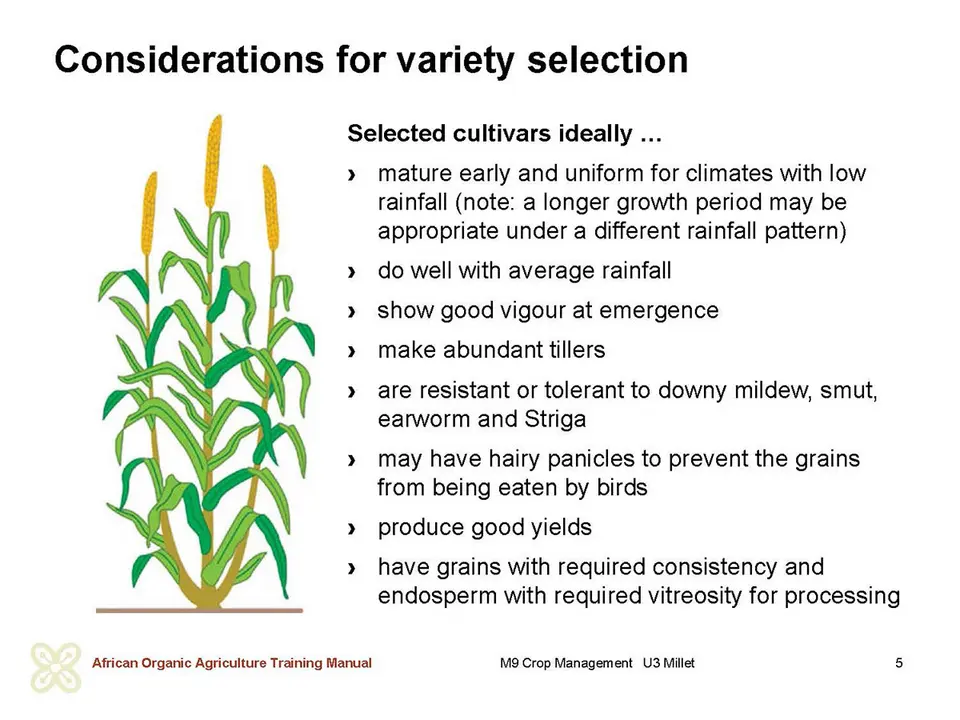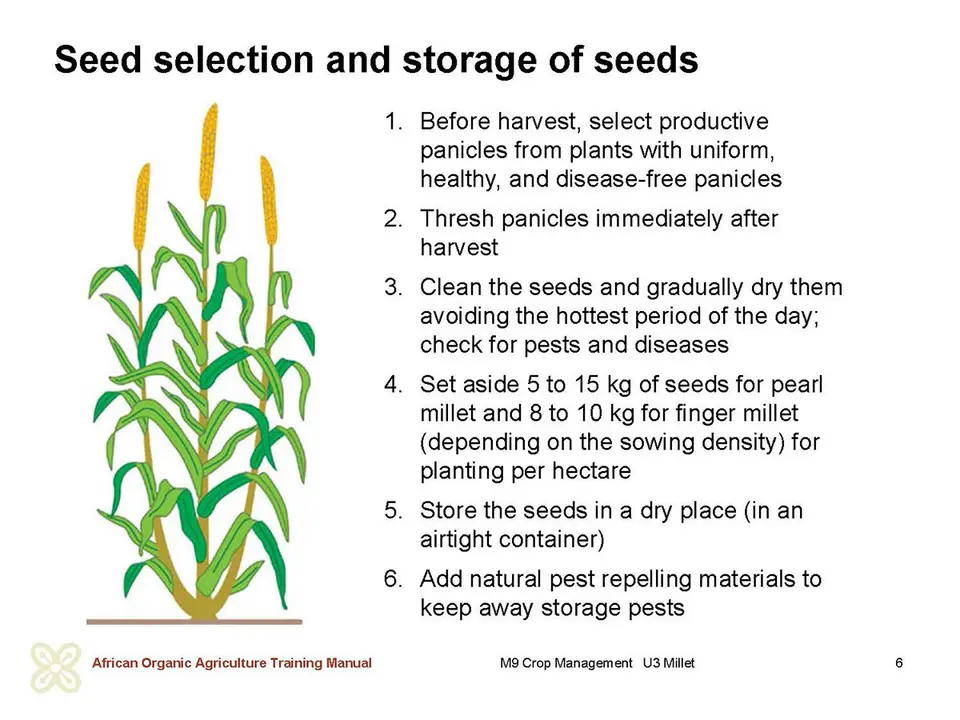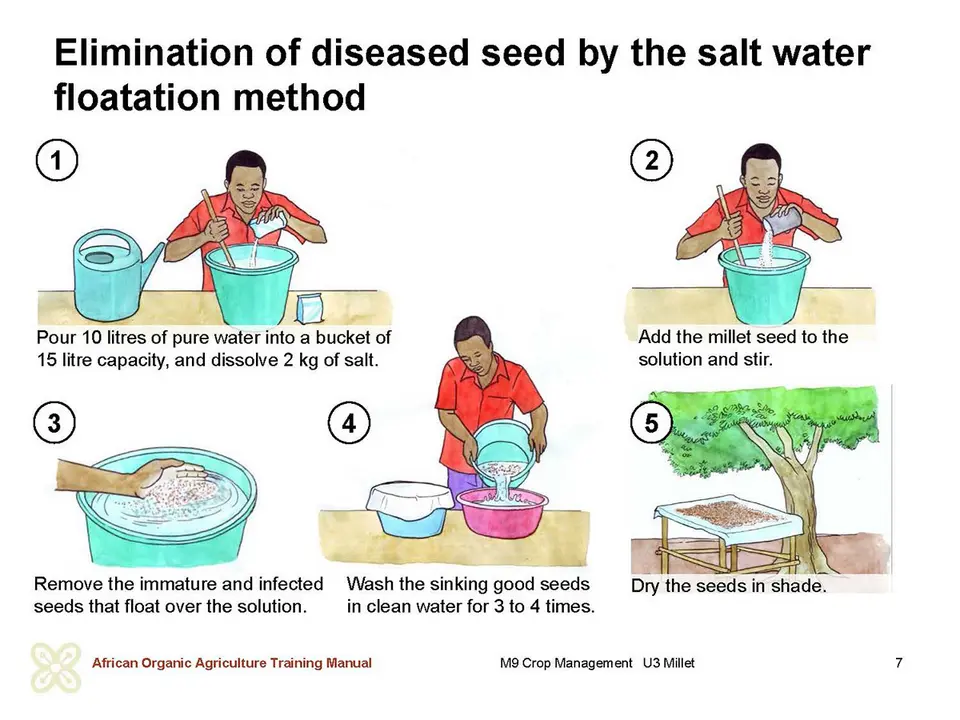Choosing the right variety to plant
Millet varieties differ in many respects. The time to flowering, plant height and leaf numbers vary among varieties. Millet occurs with different shape, structure and size of the panicle. In some varieties, the panicle is open and erect; in others it is compact and head-like. Other attributes which vary include i) tolerance to drought, ii) pest (including birds) and disease tolerance, iii) tillering capacity, iv) height of plant, v) time to maturity, vi) yield, vii) grain colour and size, viii) size of hairs (bristles) on the panicle, ix) length of grain storage, x) hull and grain processing characteristics, and xi) milling quality.
Although traditional cultivars have a low yield potential, they have the advantage of being well adapted to local growing conditions. However, improved cultivars have shorter growth duration of 75 to 80 days, higher protein content, and may attain higher yields even under conditions of drought-stress and low nutrient level. Some cultivars are resistant to diseases like blast and rust. The local extension services may be able to give more information for choosing the right millet cultivar.
Discussion: Selection of millet varieties
Invite the farmers to share their experiences with locally available millet cultivars. You may ask them:
- Which criteria do you normally consider when selecting millet cultivars to grow?
- How do you select and store seeds for the next season’s crop? Do you face any challenges and how do you address them?
- Do you have any experiences with improved millet varieties?
- Do you buy millet seed or do you produce your own? How can you tell that it is the best variety for your area?
Recommendations to farmers for good variety selection:
- Use early and uniform maturing varieties to increase yield security in climates with low rainfall, as periods of drought can be avoided. Cultivation of short season cultivars furthermore may allow growing a second crop, ideally a legume.
- Before scaling-up production of a new cultivar, test it first on a small scale.
- For best results and to minimize risk of crop failures, choose cultivars that do well with average rainfall, show good vigour at emergence, abundant tillering, are resistant or tolerant to downy mildew, smut, earworm and Striga and produce good yields.
- Hairy panicles prevent the grains from being eaten by birds. For processing, the consistency of the grains and the vitreosity of the endosperm are also important characteristics.
Seed selection and saving
Traditionally, farmers saved seeds from one season for sowing during the next season. Over the years, breeding programmes have produced improved varieties of millet of which farmers can buy seed and grow. However, there are farmers who still save their own seed for various reasons. To save own seed, the farmers select panicles from the best plants which they identify before harvest. Panicles from these plants are then harvested and stored separately from those to be used for consumption. Some of the attributes which farmers consider in selecting plants from which to harvest seed are plant vigour, tillering capacity, plant height, absence of disease infection, panicle size and grain size.
Panicles are not always selected before harvesting. In some cases, farmers only select the panicles for seed saving after harvest. With this method they are not able to tell the characteristics of the plants from where the panicles were harvested. It is therefore advisable for the farmers to use the first approach where panicles are selected before harvesting so that farmers also consider the plant characteristics in selecting the seed.
After thorough drying on wooden racks or on a flat rock preferably in the shade until they are dry (after one week or when the seed moisture content gets to 12 %), the panicles are threshed and seed is further dried if necessary, particularly if the grains are larger and drying on the panicle is slower. When properly dried, the seed is mixed with ash and then stored in bags in huts used for cooking where the smoke and heat help to preserve the seed from pests and diseases. Seed can also be stored in clay pots to keep them cool and protect them from pests. Alternatively, the seed can also be stored with leaves of plants such as neem and Tephrosia, or with pyrethrum to deter pests. If farmers intend to keep the seed for longer periods, seeds should be dried to around 8 to 9 % moisture while even lower moisture of 5 to 7 % is encouraged for long term storage of the seed. To prevent the seed from absorbing moisture during storage, they should be stored in sealed containers which are not permeable to moisture.
Controlling diseases in millet seed
Seed borne diseases such as ergot (described in more detail in a later section) can affect the panicles and carry the pathogen to the next crop. Farmers are encouraged to remove affected panicles/plants to avoid diseases spread. However, the infected seeds must also be eliminated from the seed lot. In India, the salt water floatation method is used to separate or eliminate ergot infected seeds.
Treating the seeds with 600 g of Azospirillum (Azospirillum brasilense, a nitrogen-fixing bacterium found in the rhizosphere of various grass species) per 4 kg seed and with Phosphobacterium will enhance the availability of nitrogen and phosphorus to the subsequent millet crop.
Seed treatment and preventing seed from absorbing moisture during storage
Non-toxic chemicals can be used to protect pearl millet seed. The method reported by TamilNadu Agritech is to treat the seeds with a halogen mixture at the rate of 4 g per kg of seeds. Calcium oxychloride + calcium carbonate + Albizia amara leaf powder are mixed in the ratio of 5:4:1 and stored in an air-proof container for a week to prepare the halogen mixture before applying it to the seed. To prevent the seed from absorbing moisture, moisture vapour proof containers like polyethylene bags (of 700 gauge thickness) must be used for seed that has moisture content 8 % or less. Polylined cloth bags can be used for seed at 10 % moisture content. It is important to place the bags on wooden pallets to prevent absorption of moisture from the floor and walls. If large quantities of millet seed have been produced, bags should not be over-stacked (more than 7 bags per stack) as this will exert pressure to the seeds in the lower bags causing loss of seed viability.



 tap and then scroll down to the Add to Home Screen command.
tap and then scroll down to the Add to Home Screen command.